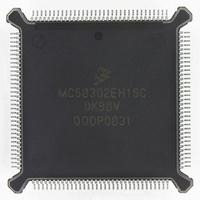MC68302EH16C Freescale Semiconductor, MC68302EH16C Datasheet - Page 212

MC68302EH16C
Manufacturer Part Number
MC68302EH16C
Description
IC MPU MULTI-PROTOCOL 132-PQFP
Manufacturer
Freescale Semiconductor
Datasheets
1.MC68302AG20C.pdf
(4 pages)
2.MC68302AG20C.pdf
(2 pages)
3.MC68302AG20C.pdf
(13 pages)
4.MC68302EH16C.pdf
(481 pages)
Specifications of MC68302EH16C
Processor Type
M683xx 32-Bit
Speed
16MHz
Voltage
5V
Mounting Type
Surface Mount
Package / Case
132-MQFP, 132-PQFP
Controller Family/series
68K
Core Size
32 Bit
Ram Memory Size
1152Byte
Cpu Speed
16MHz
No. Of Timers
3
Embedded Interface Type
SCP, TDM
Digital Ic Case Style
PQFP
Rohs Compliant
Yes
Family Name
M68000
Device Core
ColdFire
Device Core Size
32b
Frequency (max)
16MHz
Instruction Set Architecture
RISC
Supply Voltage 1 (typ)
5V
Operating Temp Range
0C to 70C
Operating Temperature Classification
Commercial
Mounting
Surface Mount
Pin Count
132
Package Type
PQFP
Lead Free Status / RoHS Status
Lead free / RoHS Compliant
Features
-
Lead Free Status / Rohs Status
RoHS Compliant part
Electrostatic Device
Available stocks
Company
Part Number
Manufacturer
Quantity
Price
Company:
Part Number:
MC68302EH16C
Manufacturer:
Freescale Semiconductor
Quantity:
135
Company:
Part Number:
MC68302EH16C
Manufacturer:
PANA
Quantity:
99
Company:
Part Number:
MC68302EH16C
Manufacturer:
Freescale Semiconductor
Quantity:
10 000
Part Number:
MC68302EH16C
Manufacturer:
FREESCALE
Quantity:
20 000
Company:
Part Number:
MC68302EH16CB1
Manufacturer:
Freescale Semiconductor
Quantity:
10 000
Company:
Part Number:
MC68302EH16CR2
Manufacturer:
Freescale Semiconductor
Quantity:
10 000
- MC68302AG20C PDF datasheet
- MC68302AG20C PDF datasheet #2
- MC68302AG20C PDF datasheet #3
- MC68302EH16C PDF datasheet #4
- Current page: 212 of 481
- Download datasheet (2Mb)
Communications Processor (CP)
NTSYN—No Transmit SYNC
REVD—Reverse DATA
BCS—Block Check Sequence
Bit 10—Reserved for future use.
RTR—Receiver Transparent Mode
RBCS—Receive Block Check Sequence
4-92
If this bit is cleared, the BISYNC controller will look for the SYN1–SYN2 sequence in the
data synchronization register.
When this bit is set, the SCC operates in a promiscuous, totally transparent mode. See
4.5.16 Transparent Controller for details.
When this bit is set, the receiver and transmitter will reverse the character bit order, trans-
mitting the most significant bit first. This bit is valid in promiscuous mode.
The BISYNC receiver internally stores two BCS calculations with a byte delay (eight serial
clocks) between them. This enables the user to examine a received data byte and then
decide whether or not it should be part of the BCS calculation. This is useful when control
0 = LRC
1 = CRC16
0 = The receiver is placed in normal mode with SYNC stripping and control character
1 = The receiver is placed in transparent mode. SYNCs, DLEs, and control characters
For even LRC, the PRCRC and PTCRC preset registers in the BISYNC-specific
parameter RAM should be initialized to zero before the channel is enabled. For odd
LRC, the PRCRC and PTCRC registers should be initialized to ones. The LRC is
formed by the Exclusive OR of each 7-bits of data (not including synchronization
characters), and the parity bit is added after the final LRC calculation.
The receiver will check character parity when BCS is programmed to LRC and the
receiver is not in transparent mode. The transmitter will transmit character parity
when BCS is programmed to LRC and the transmitter is not in transparent mode.
Use of parity in BISYNC assumes the use of 7-bit data characters.
The PRCRC and PTCRC preset registers should be initialized to a preset value of
all zeros or all ones before the channel is enabled. In both cases, the transmitter
sends the calculated CRC non-inverted, and the receiver checks the CRC against
zero. Eight-bit characters (without parity) are configured when CRC16 is chosen.
The CRC16 polynomial is as follows:
recognition operative.
are only recognized after a leading DLE character. The receiver will calculate the
CRC16 sequence, even if programmed to LRC while in transparent mode. PRCRC
should be first initialized to the CRC16 preset value before setting this bit.
MC68302 USER’S MANUAL
X 16 + X 15 + X 2 + 1
MOTOROLA
Related parts for MC68302EH16C
Image
Part Number
Description
Manufacturer
Datasheet
Request
R
Part Number:
Description:
Manufacturer:
Freescale Semiconductor, Inc
Datasheet:

Part Number:
Description:
MC68302 Configuring the Chip Selects on the MC68302
Manufacturer:
Motorola / Freescale Semiconductor

Part Number:
Description:
MC68302 Design Concept - Expanding Interrupts on the MC68302
Manufacturer:
Motorola / Freescale Semiconductor

Part Number:
Description:
MC68302 MC68302 Adapting a WAN Controller to a LAN Environment
Manufacturer:
Motorola / Freescale Semiconductor

Part Number:
Description:
MC68302 EKB Applications - Power Measurements on the MC68302
Manufacturer:
Motorola / Freescale Semiconductor

Part Number:
Description:
MC68302 Interfacing the MC68020 to a Slave MC68302
Manufacturer:
Motorola / Freescale Semiconductor

Part Number:
Description:
MC68302 MC68302 Software Performance
Manufacturer:
Motorola / Freescale Semiconductor

Part Number:
Description:
MC68302 Evaluating EDX on the ADS302
Manufacturer:
Motorola / Freescale Semiconductor

Part Number:
Description:
MC68302 Design Advisory #1 - MC68SC302 Passive ISDN Protocol Engine
Manufacturer:
Motorola / Freescale Semiconductor

Part Number:
Description:
MC68302, MC68360, and MPC860 Characteristics and Design Notes for Crystal Feedback Oscillators
Manufacturer:
Motorola / Freescale Semiconductor
Part Number:
Description:
Mc68302 Integrated Multi-protocol Processor
Manufacturer:
Freescale Semiconductor, Inc
Datasheet:
Part Number:
Description:
Manufacturer:
Freescale Semiconductor, Inc
Datasheet:
Part Number:
Description:
Manufacturer:
Freescale Semiconductor, Inc
Datasheet:
Part Number:
Description:
Manufacturer:
Freescale Semiconductor, Inc
Datasheet:
Part Number:
Description:
Manufacturer:
Freescale Semiconductor, Inc
Datasheet:











